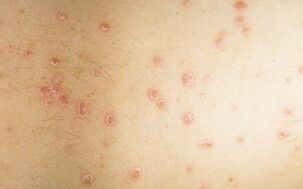According to official figures, approximately 3% of people worldwide suffer from psoriasis. But it can be assumed that the actual number of patients with this type of dermatosis is much higher. Basically, the first signs of such ailment appear at the age of 10-25 years, although cases of diagnosis of psoriasis have been recorded in both babies and the elderly. It is not yet clear why it develops, but doctors have information about what the early stage of psoriasis looks like. Therefore, with timely referral to specialists, you can be able to stop the progression of the disease in the earliest stages.
Early Stage Symptoms
Initially, small round papules begin to appear on the patient's skin, the size of which, as a rule, does not exceed the diameter of the head of a pin. These formations have a smooth, shiny surface and clear outlines, but literally after a few days they start to peel off. The resulting scales are silvery-white in color and can be easily removed from the surface of the papule. Over time, the number and size of the elements of the rash increase and the disease progresses to a progressive stage.
Papules are usually reddish or pinkish in color, although in some situations they turn bluish. This is observed with the formation of the primary elements of a rash on the legs. Depending on the type of ailment, the initial stage of psoriasis appears on the elbows (extensor surfaces), knees, body, extremities, or scalp.
If you remove all the grain flakes, you will find an absolutely smooth shiny surface underneath them: the terminal film. But with more scraping, it gets damaged quickly and the smallest drops of blood begin to appear.
Therefore, psoriasis is characterized by three specific phenomena:

- stearin stain: increased flaking by removing scales;
- psoriatic film- exfoliation of the thinnest layer of skin;
- blood spray: the appearance of small drops of blood after scraping.
But it is much easier to see what the early stage of psoriasis looks like in a photo.
Despite all the advances in medicine, no remedy has been developed today that completely cures psoriasis. This disease is characterized by a wave-shaped course, therefore, not only those who first encountered a similar ailment, but also those who have been living with it for many years, go through the initial stage of its development.
I would like to emphasize that there is no cure for psoriasis. With the help of modern drugs, physiotherapy procedures and other methods of therapy, you can "drive" the disease into a state of stable remission, and, perhaps, even forget about it for several years. But this does not mean that in an unfavorable combination of circumstances, the patient will no longer notice the characteristic rashes that manifest the initial stage of psoriasis on the hands and other parts of the body.
How do you know if psoriasis is progressing?
The transition from psoriasis to the second stage or progressive stage is evidenced by the growth and fusion of previously single papules, as well as the addition of itching so far absent. Furthermore, the nature of the peel also changes. It is now seen only in the center of the formations, and their edges are free of scales. This clearly indicates the growth of elements.
To confirm the transition from psoriasis to the second stage, you can use a kind of test. Its essence consists of minor damage to the skin of the affected area. If, after about a week, a psoriatic element forms in the same way as the lesion in the same place, this clearly indicates the progression of the disease. In the specialized literature, this test is described as a Kebner symptom. Also, this is observed even with banal combing of the affected skin.
In some cases, patients have exudative psoriasis. It is characterized by the release of a special fluid. The scales are impregnated with it, as a result of which they turn into dense crusts. If one of these scabs is removed or damaged, the oozing area of skin is exposed.























